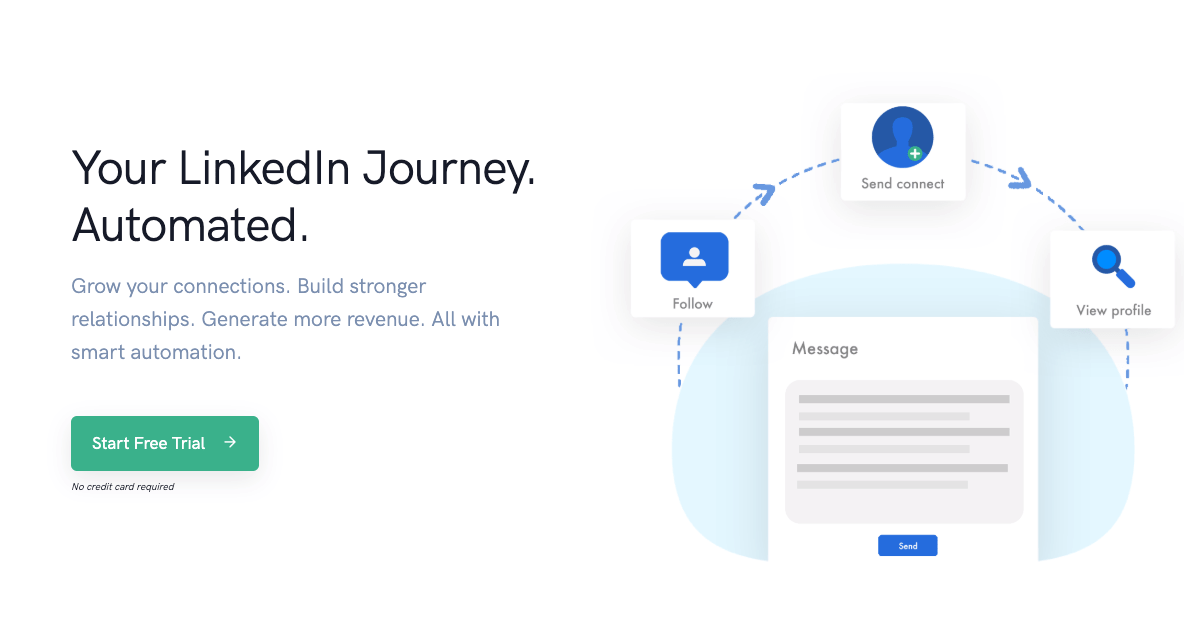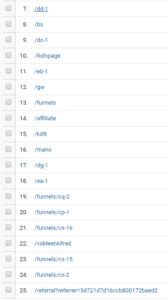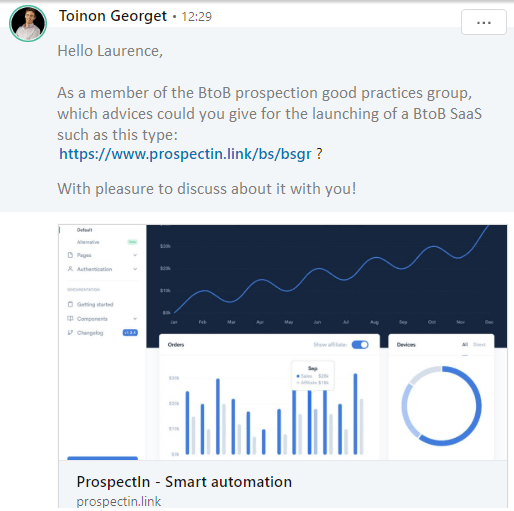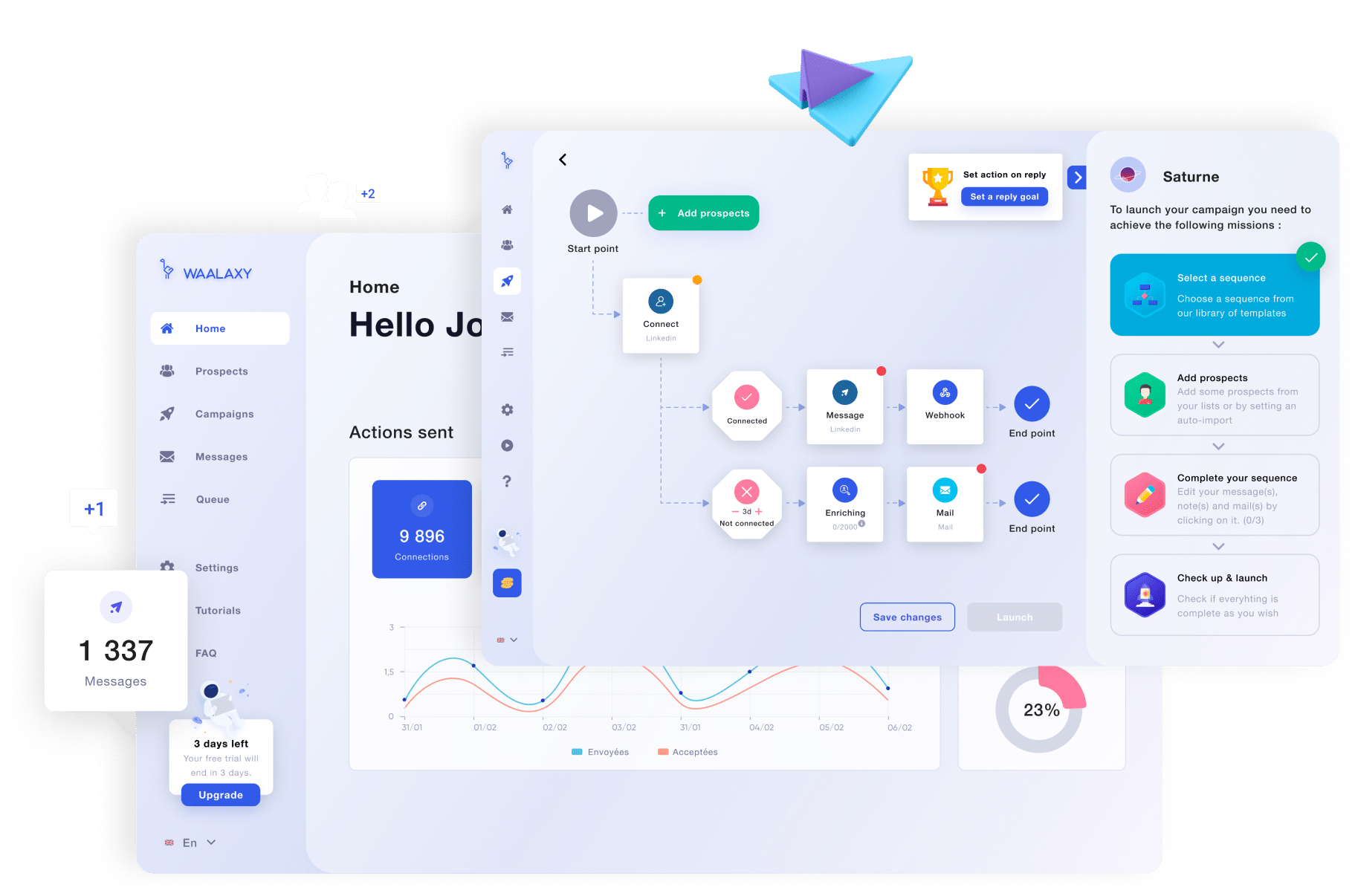
There’s no good documentation without bonuses, so we’ve compiled a few treasures for those who love tips.?
Master prospecting on LinkedIn with these 5 tips
Through our Ambassador program, we have managed to attract some of the greatest LinkedIn experts, wishing to promote our prospecting tool – ProspectIn – to their customers. We have selected 5 of the best tips from these LinkedIn experts to help push your prospecting on LinkedIn to new heights.
Hack 1 – This is real life.
“Ask yourself a simple question before pressing the send button: does this message perfectly correspond to the way in which I have approached a prospect in real life at a networking event?” Florian Bourguignon, LinkedIn Prospecting Expert.
We know we’re not starting off easy, but this is a fundamental question: why should you approach prospects in real life differently than on LinkedIn? The answer: in real life, you can always correct a mistake. But if your prospect declines your invitation on LinkedIn… It’s over!
Very often people say to me “I would never say that to a prospect in real life. Why should I say it on LinkedIn? ”
Sending a message on LinkedIn is like breaking the ice at a networking events, except that instead of making a comment about the wine or the quality of the cheese platter, or the speaker you just saw, you have dozens of much more qualitative icebreakers thanks to the information on their profile.
It is important to not lose a human touch, and to get the perfect balance between a laid-back approach and professionalism.
Hack 2 – Short messages to optimize your B2B prospecting on LinkedIn
“Write short messages. People don’t have the time.” By Adrien Croville, co-founder of Mentor-Marketing.
This is a fundamental concept. However, I have already been targeted with messages of more than 1300 words. 1300 words! This is an article, not a message.
Florian Bourguignon even specifies:
“Do not exceed 600 characters in the first message after the invitation.”
Remember that you are only in the line of vision of your prospect. In order words, they don’t care about you (yet). Don’t stuff them with information. Instead talk to them about your expectations regarding your connection, and discuss points of common interest. That leads me to a third point.
Hack 3 – A clear call to action to boost your customer base
You don’t arrive at an unprepared sales interview without knowing exactly what you want. So don’t do it with your prospects on LinkedIn.
“Only one objective per message. (You don’t want to sell your services from the first message)” , Adrien Croville.
It is essential to define precisely:
- Who your target is.
- Why you are contacting them, and why now.
- What you expect from them.
- Finally, how are you going to call them to action.
Florian Bourguignon adds:
Clearly define your sales objectives at the start, to quantify the time and the number of campaigns required.
Don’t waste time on cold prospects.
Hack 4 – Don’t just prospect, give value
This is an article on prospecting. But we can’t talk about prospecting without talking about having an optimized profile and creating content.
“LinkedIn works on a profile/messages/content triptych: one cannot work without the other two, and each must be properly optimized” Benoît Dubos, co-founder of Grooswter.co, a marketing agency which produces courses with high added value on LinkedIn best practices.”
We couldn’t have said it better ourselves. Adding prospects to LinkedIn is good. But it is not enough. By creating content, you bring value to your future customers. By sharing it on LinkedIn, you increase your credibility and your “expert” status in the field.
You must seriously consider optimizing your profile, as it is your business showcase. Your profile is the door to your website!
Hack 5 – Stand out from the mass
“Take the opposite of what is commonly done”, Benoît Dubos
If you are someone who receives several prospecting connection requests per day, take a second to think about them. What/who do you remember? Only those who stand out!
I would even add: Be original. Test new things. Create and try-out approaches that you’ve never seen before. Sometimes it works. Sometimes it doesn’t. But with automation, you can test, measure and iterate. Until you find an approach that works, and identify those that don’t work.
A bonus tip for prospecting on LinkedIn…
“Be nice and/or be a woman”, Benoit Dubos (once again).
Just kidding!
Not really ? Let me explain:
Staying polite and friendly, even if a prospect tells you where to go (which is inevitable when you test original messages), is a no-brainer. But some of you might be surprised to hear that we also found that female profiles obtain much higher acceptance and response rates.
What about you? Do you have a tip to share regarding prospecting on LinkedIn? ?
How to generate 1000’s of qualified leads on LinkedIn?
You have a good product or service, and a good sales funnel (this step is essential). The next question is how to generate 1000’s of leads per week so as to accelerate your activity.
ProspectIn’s Story

I’ll tell you the story of ProspectIn. Initially, we were developing an app for hotels. We didn’t have a super funnel. Nor a great product.
But we knew that we still had to find customers. LinkedIn seemed like the ideal place to find new customers. But being as lazy as we are, we did not want to do it by hand. ?
After some research, we found tools like Linked Helper and Dux-soup. We did a free trial and quickly understood that these tools were obsolete.
So, we decided to develop our own tool internally. By talking to other entrepreneurs around us, we realized that there were quite a lot of us with the same need. So we marketed our product and gave up our first project to work full time on ProspectIn.
Why am I saying all of this?
Because today, I would like to share with you what we have learned over the past 6 months on how to develop your BtoB business and how we have managed to reach more than 1000 downloads per month.
Generate 1000’s of leads by week
Test, assess, iterate
I believe this is a fundamental concept for lead generation and entrepreneurship in general. There is no point in deliberating for hours on the best solution. Find an idea and test it. Right here, right now. Assess these results. Iterate on what works.
Thanks to automation and digital tools, you can contact dozens of people, measure the results and try to improve.
Let’s take an example: I thought that contacting people who had joined a group on a specific topic was a good idea. First, I tested a group gathered around leads generation. I obtained good results. Then, I refined my approach based on feedback. I ended up getting more than a 50% acceptance rate. (information bellow. ?)
A second example: I thought that contacting growth hacking agencies to sell them our product was a great idea. I scoured pages of Growth Hacking agencies to find and contact decision-makers. I got ridiculous conversion rates and stopped contacting them. Yet on paper, it was a much better idea than trying to find prospects on LinkedIn groups.
Be original
This advice goes with the previous one. Today your prospects receive several invitations per day. You have to differentiate yourself so that your voice doesn’t get drowned out in the crowd.
So test original strategies: an open and provocative question, a gif, an audio message. In short, show how much you can add value to your prospect.
Put yourself in your prospect’s shoes
Put yourself in the shoes of your prospect. Ask yourself, what do they want? Certainly not receiving a “Hello I want to sell you XXX” message.
No, they want to know that you are interested in their problems. Show some interest in their professional activity. Go on their profile. Look at what they do and why they do it. Draw them into a conversation! Be friendly. Interact with their posts.
A satisfied prospect is not only a future client, but also a future ambassador of your product or service.
Automate. Scale your business.
You have tested and found something that works. It’s time to automate it – to scale it up. Not a minute to lose, you need to refine your technique.
In the beginning, we were prospecting with 3 or 4 LinkedIn accounts. When we realized that we were getting good results, we went to 10 and then to 20.
By iterating on our strategies and methods, and optimization our profiles, we have been able to generate thousands of qualified leads on LinkedIn! ?
10 funny follow-up messages on LinkedIn
At ProspectIn, we generally get between a 10 and 20% message response rate on LinkedIn, and between a 5 and 10% response rate for our invitation notes.
So it made sense that we asked ourselves the question: how can we approach these 70 to 80% of prospects who did not respond to our requests? The response: Funny follow-up messages!
Here are the advantages of following-up with your customers:
- Boost the conversion rate on your prospect/customer base.
- Make your community loyal.
- Get new customers.
- Automate your prospection using our ProspectIn tool.
Below we’ve rounded up our top interesting or/and funny follow-up messages on LinkedIn for an automated strategy.
Feel free to copy some of these templates for prospects who have accepted your invite but have not responded to your messages. We warn you in advance, some are quite bold!
Funny follow-up message #1: The forgotten one
“Hello {{firstname}},
I never got an answer from you… This makes me very sad. Have you forgotten about me?
Too many people forget about me… ? “

Funny follow-up message #2: The Farmer
“Words sow, silence harvests. {{firstname}}, should I assume that contrary to what your LinkedIn profile suggests, you’re actually in the agriculture business?”

Funny follow-up message #3: Your Favorite Quote
Between these 3 quotes, which one would you say best sums up your lack of response to my previous message:
“What’s fun is to throw a bottle in the sea and believe that it will bring the answer. “
“Often, silence is an answer.”
“By questioning the man, we wait for God’s answer.”

Funny follow-up message #4: The Price of Silence
“Speech is worth money, silence is worth gold. At the current price of gold (around €42,990.00 per kg), I think it’s safe to say a ProspectIn subscription is well within your means.”

Funny follow-up message #5: The Special Offer
“What do you do when someone’s ignoring you? Brib- I mean give them a treat! Here is a coupon for 50% off. Don’t let it go to waste.”

Funny follow-up message #6: Am I a fool?
“Silence is the best answer you can give to a fool. A friend recently told me this. Is that why I never heard from you?”.

Funny follow-up message #7: The story time
“Hey {{firstname}}, I’m trying to understand why I never got an answer from you.
When we connected I saw a vision of us building a long-lasting and mutually beneficial business relationship. With every day that passes and I don’t hear from you, I begin to wonder if I’ve got it wrong.
It reminds me of the time when I was a child and I asked my mom what the meaning of life was…
It was a hot summer’s day. We were on vacation in the south of Italy, and I’d ordered a gelato. This was my first time trying gelato in Italy. I chose chocolate. Three scoops. With each lick, I got visions of joy and splendour and a paradise on Earth. Then the unthinkable happened. I tripped and somehow dropped the gelato. Face down, on the streets of Sicily.
I’d got a taste of paradise – and somehow I’d let it slip away. As I watched the chocolate puddle get bigger and bigger, I tried to hold back the tears. Maybe there wasn’t a paradise on Earth. Maybe I had got it all wrong. I turned to my mom, and in the way only a 6 year old could, I asked “Mom, what’s the meaning of life?”.
Now, I was not prepared for her response, and it’s likely you aren’t either…”

Funny follow-up message #8: If only…
“If only my LinkedIn automation tool allowed me to send gifs, we wouldn’t be where we are now (you ignoring me)…
I’m pretty sure a good gif would have been the key to your heart!
I think you would have perfectly loved this one:
Oh wait, I forgot I can’t post gifs. Back to the drawing board I go…
There must be another way to spark your curiosity.”
Funny follow-up message #9: Misunderstood Quote
“Who is true, he cannot say. But who is silent by truth, his silence says nothing.” I found this quote whilst searching for quotes related to silence/being ignored. I consider myself a bit of a poet, but I gotta admit, that one had me completely lost. If you manage to solve this riddle of a poem, please let me know! “

Funny follow-up message #10: The Updated CRM
“You have to twist your tongue in your mouth seven times before speaking”.
May I know at which round you’re at?
I’m asking cause I need it to solve the very mathematical formula for when you are going to respond. I’d be happy to share the formula with you if you are into Math…or wondering when you crush will respond to that risky message you sent after a bit of Dutch courage (oops)”.

Obviously, you will not get a 50% response rate with these messages. And even if you do, some people’s responses won’t be the nicest, as they might be quite closed-minded to anything that isn’t a standard corporate promotional message.
But for the most part, you will generate more leads with these teasers, as opposed to you not following-up at all, or you following-up with a standard dull message. The best part is, occasionally you even get a few very enthusiastic responses!
The goal is to follow-up several times, testing different methods each time, until you find the one that works best.
If you do it enough times, you might even end up being the one to write the next top 10 funny follow-up messages on LinkedIn. How brilliant would that be? ?
How to get a 51% acceptance rate and a 14.5% response rate on LinkedIn
I must warn you right now: we don’t have magic powers. The method shown here is so easy that you won’t have any excuse to not set it up right away. Come on, go on your LinkedIn account ?.
How to increase your response rate on LinkedIn?
In this article, I’m going to explain to you how we obtained:
- A bit over a 50% connection acceptance rate.
- A 15.5% message response rate.
- 14.7% more unique qualified visits on our website.
- 60% more time spent on our site compared to our previous average score.
- 7 calls with potential ambassadors of our solution.
All that from a Campaign with only 483 prospects – which adds up to just one week of LinkedIn message automation ?)
During that period of time we were regularly getting responses like:
- “I’ll see if I can take the time to check it out! I really like your initial contact approach.”
- Hello Toinon, very very good strategy for getting your message across! I personally work the direct approach and I think this one is really awesome”.
- “I would just like to say that your LinkedIn approach is great”.
- “Great message bro! It convinced me to try out your tool, and I have to say I’m pretty impressed. It’s kind of a pretty version of LinkedHelper! “



Before we begin, I’d like to say straight off the bat that I’m not able to say exactly how many active and paid users we generated with this campaign. I’m sure some purists will be after neck, but unfortunatrly my tracking system wasn’t working during the Campaign. I’m aware this is not ideal… I promise I’ll do better next time ?
1. Test and iterate
« Everything that can be measured can be improved »

Know that this successful campaign was a result of many tests we ran on multiple accounts for several months. Beyond promoting ProspectIn, we can no longer launch blind prospecting campaigns. We have to set up tools to measure performance.
Some ways to measure your prospecting performance: using a tracked link with bitly; setting up a dashboard that allows you to follow your cohorts; or using an automation tool which gives you your message or/and Campaign performance stats. Whatever method you use, the essential is that you measure your strategies!
Launching a Campaign without tracking and measuring your results, is akin to training for a marathon without ever timing yourself. How do you know if you’ve improved?
At ProspectIn, we track everything. Like really, everything. We’ve internally developed a follow-up tool that allows us to measure our cohorts. Every A/B test and every persona is tracked to confirm or invalidate our hypotheses.
What is a cohort? For us, it means measuring quite a few indicators, in a given period. Who comes back after one week? Two weeks? One month? Who pays? Who uninstalls our extension?
Here is an overview of our dashboard and the Key Performance Indicator that we follow for our campaigns. I can’t recommend a particular tool for this, as we use an internal tool. But I’m sure if you have a look around you’ll be able to find a very good SaaS that fits your needs.

So this Campaign is the result of many iterations and a lot of tracking. When we say a lot, we really mean it – here’s a screenshot of our Google Analytics if you’re curious:

We really track everything!
2. Standard commercial methods on LinkedIn no longer stand-out
Our initial-contact approach is based on the following hypothesis: prospecting on LinkedIn is more and more common. Decision-makers’ profiles are often over-saturated. Even though finding qualified leads on LinkedIn still works relatively well (even with a standard approach), finding a way to stand-out will give you an edge.
I myself receive dozen of invites per day. Pretty much every single one has a business angle.
Before explaining the very simple approach we adopted, I quickly want to remind you that this will not work for every line of business, nor for every prospect.
The best way to find the best note for your business and for your prospects is:
- Write a dozen original initial-contact messages. If you are a team, do it separately.
- Brainstorm and iterate to make it even better.
- Select the best 5.
- Test and measure.
- Iterate on the most successful and start again.
3. Use LinkedIn groups, a great prospects’ pool
After searching for specific personas using LinkedIn’s search feature, and receiving mostly low granular level results (even with the Sales Navigator option), I eventually made the decision to go fishing in another pond: LinkedIn groups.
People who join these LinkedIn groups are qualified targets:
- They are searching for information, content or to discuss the group’s subject
- It’s safe to assume that they’re at least a little bit active on LinkedIn
My subject being BtoB leads generation on LinkedIn, I chose people belonging to the French group “Prospection commerciale BtoB : les bonnes pratiques” (“BtoB commercial prospecting: Best practices”) via Sales Navigator. Seems like a good idea as we’re in the smart automated tools business.
NB: If your client acquisition strategy relies largely on LinkedIn, we highly recommend getting a Sales Navigator plan. Coupled with an automated LinkedIn prospecting tool, Sales Navigator is very powerful. Of course it is an investment, but it allows you to apply a greater level of specificity when searching for prospects, which is very beneficial.
4. The open-question approach
Prospects who are already clued on to the world of prospecting, will be able to identify this strategy almost immediately. But, this is often what gets Sales Specialists to click on your link: offering them a different method/strategy/tool, than the one that they’re currently using. That will grab their curiosity real quick.
We put this into practice by asking prospects for a tip or advice based on their experience launching a BtoB SaaS. Of course, the SaaS we asked for their advice on was our own tool. The aim of this approach is to get your prospects to go directly to your website.
Here’s an example:

We can observe:
1) A customized message where the prospect is addressed by name
2) Further customization by mentioning their membership to a group. This reminds them that they’re interested in the subject and they are an expert in the subject matter
3) A customized landing page where there’s a conversation specially centre ’round BtoB sales
4) A traceable link to measure the Campaign’s performance
5) A wonderful image (which isn’t even directly from the tool ), but gets the prospect dreaming of higher conversion rates and a better performance
6) A persuasive slogan: here we went for “Smart automation”. For a part of the Campaign I also used the slogan “Improve your conversion rates on LinkedIn”, but I don’t have data to tell you if that had any impact.
5. A mild and non-intrusive follow-up
Continuing on from the first message, I send a follow-up message to strengthen my intention to find tips to boost my client acquisition. The follow-up is sent between 3 to 5 days after the connection.
This example is a bit long for a follow-up, but the aim here was to create a “reminder”. This type of message is aimed at prospects who accepted me and thought “I’ll respond later”, but simply forgot to. With this follow-up message I obtained a 10% response rate, which is a pretty good.
Tip: Don’t hesitate to automate your follow-ups!
“Hello {{firstname}},
Thanks for accepting me into your network! Did you see the link I sent you?
Any thoughts on it?
If you have some personal tips or advice on how to improve client acquisition in B2B, I’m all ears!
Looking forward to hearing back from you”.
6. Strike up a conversation and be responsive
Once your prospect responds, strike up a conversation before attempting to sell anything. In this Campaign, some people wrote me detailed answers about our tool or our landing page – without us ever trying to sell them our tool. Our website is clear enough: if they didn’t find value in our product, never-mind. Some people will argue that I should insist more. Personally I’d rather adopt a qualitative approach!
Of course, we also had some people who never responded to our messages, but went on to directly download ProspectIn. Obviously, if you have a website that doesn’t convert well or you sell a more complex service, this won’t work and you’ll need to find your OWN original way of approaching prospects.. If you are looking for some ideas on messages and follow-ups that will spark curiosity, here’s an articule to get those creative juices flowing.
If you have other tasks in the day (God knows I do), I advise you to do 2 to 3 sessions of 30 minutes per day where you manage your messages. You can schedule your messages, and it really doesn’t take up much time. The rest of the time, hide your LinkedIn tab and mute all your notifications.
Take this case study as a humble example. A test which worked for us. A result of various iterations. My advice is for you to use the guidelines provided to create your own success.
One last tip: automate your LinkedIn! Believe me when I say that it will save you a lot of time and get you way better results.
Feel free to share this ultimate guide as much as you want.
We hope you enjoyed it.
It’s been made with ?.
👈 Going back to step 5










